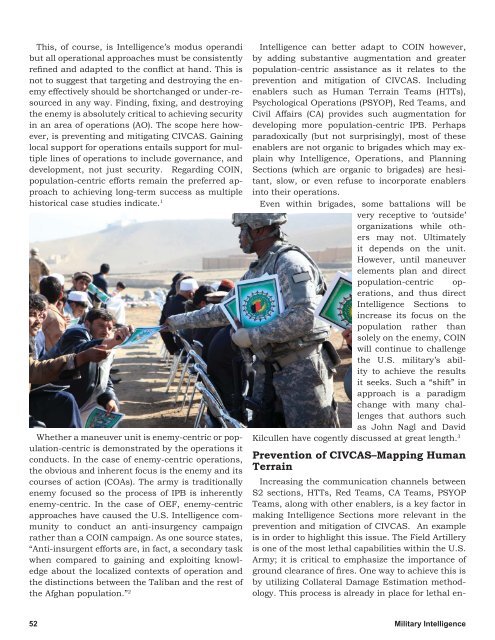George w. casey jr. - Federation of American Scientists
George w. casey jr. - Federation of American Scientists
George w. casey jr. - Federation of American Scientists
You also want an ePaper? Increase the reach of your titles
YUMPU automatically turns print PDFs into web optimized ePapers that Google loves.
This, <strong>of</strong> course, is Intelligence’s modus operandi<br />
but all operational approaches must be consistently<br />
refined and adapted to the conflict at hand. This is<br />
not to suggest that targeting and destroying the enemy<br />
effectively should be shortchanged or under-resourced<br />
in any way. Finding, fixing, and destroying<br />
the enemy is absolutely critical to achieving security<br />
in an area <strong>of</strong> operations (AO). The scope here however,<br />
is preventing and mitigating CIVCAS. Gaining<br />
local support for operations entails support for multiple<br />
lines <strong>of</strong> operations to include governance, and<br />
development, not just security. Regarding COIN,<br />
population-centric efforts remain the preferred approach<br />
to achieving long-term success as multiple<br />
historical case studies indicate. 1<br />
Whether a maneuver unit is enemy-centric or population-centric<br />
is demonstrated by the operations it<br />
conducts. In the case <strong>of</strong> enemy-centric operations,<br />
the obvious and inherent focus is the enemy and its<br />
courses <strong>of</strong> action (COAs). The army is traditionally<br />
enemy focused so the process <strong>of</strong> IPB is inherently<br />
enemy-centric. In the case <strong>of</strong> OEF, enemy-centric<br />
approaches have caused the U.S. Intelligence community<br />
to conduct an anti-insurgency campaign<br />
rather than a COIN campaign. As one source states,<br />
“Anti-insurgent efforts are, in fact, a secondary task<br />
when compared to gaining and exploiting knowledge<br />
about the localized contexts <strong>of</strong> operation and<br />
the distinctions between the Taliban and the rest <strong>of</strong><br />
the Afghan population.” 2<br />
Intelligence can better adapt to COIN however,<br />
by adding substantive augmentation and greater<br />
population-centric assistance as it relates to the<br />
prevention and mitigation <strong>of</strong> CIVCAS. Including<br />
enablers such as Human Terrain Teams (HTTs),<br />
Psychological Operations (PSYOP), Red Teams, and<br />
Civil Affairs (CA) provides such augmentation for<br />
developing more population-centric IPB. Perhaps<br />
paradoxically (but not surprisingly), most <strong>of</strong> these<br />
enablers are not organic to brigades which may explain<br />
why Intelligence, Operations, and Planning<br />
Sections (which are organic to brigades) are hesitant,<br />
slow, or even refuse to incorporate enablers<br />
into their operations.<br />
Even within brigades, some battalions will be<br />
very receptive to ‘outside’<br />
organizations while others<br />
may not. Ultimately<br />
it depends on the unit.<br />
However, until maneuver<br />
elements plan and direct<br />
population-centric operations,<br />
and thus direct<br />
Intelligence Sections to<br />
increase its focus on the<br />
population rather than<br />
solely on the enemy, COIN<br />
will continue to challenge<br />
the U.S. military’s ability<br />
to achieve the results<br />
it seeks. Such a “shift” in<br />
approach is a paradigm<br />
change with many challenges<br />
that authors such<br />
as John Nagl and David<br />
Kilcullen have cogently discussed at great length. 3<br />
Prevention <strong>of</strong> CIVCAS–Mapping Human<br />
Terrain<br />
Increasing the communication channels between<br />
S2 sections, HTTs, Red Teams, CA Teams, PSYOP<br />
Teams, along with other enablers, is a key factor in<br />
making Intelligence Sections more relevant in the<br />
prevention and mitigation <strong>of</strong> CIVCAS. An example<br />
is in order to highlight this issue. The Field Artillery<br />
is one <strong>of</strong> the most lethal capabilities within the U.S.<br />
Army; it is critical to emphasize the importance <strong>of</strong><br />
ground clearance <strong>of</strong> fires. One way to achieve this is<br />
by utilizing Collateral Damage Estimation methodology.<br />
This process is already in place for lethal en-<br />
52 Military Intelligence















